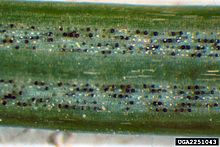| Phaeocryptopus gaeumannii | |
|---|---|

| |
| Fruiting bodies of Phaeocryptopus gaeumannii | |
| Scientific classification | |
| Kingdom: | |
| Division: | |
| Class: | |
| Order: | |
| Family: | |
| Genus: | |
| Species: | P. gaeumannii
|
| Binomial name | |
| Phaeocryptopus gaeumannii | |
| Synonyms | |
|
Adelopus gäumanni T.Rohde (1936) [2] | |
Phaeocryptopus gaeumannii is a fungus that infects Douglas fir and causes Swiss needle cast, a yellowing of foliage and reduction in growth. It is endemic in western North American stands of Douglas fir, but was first discovered in Douglas fir trees planted Switzerland. When trees in America were checked, it was found that the fungus was common but apparently caused no disease. However, in the 1980s and 90s the disease became noticeable and problematic. [3] [4]
The classification of Phaeocryptopus gaeumannii within the Venturiaceae has been questioned, with molecular studies placing it in the Mycosphaerellaceae ( Capnodiales), close to species of Mycosphaerella and Rasutoria, such as Rasutoria pseudotsugae and Rasutoria tsugae. [5]
The fungus infects trees in the spring, and continues to develop over the following winter. The fungus causes yellowing ( chlorosis) of the needles, with eventual necrosis and premature needle-drop. In some heavily diseased stands of trees, the only needles remaining are those of the current year, in which the disease has not yet had time to fully develop. The overall result for the infected tree is reduced growth. [6] [7]
The fungus is temperature dependent within the Douglas fir range, with the highest level of infection in the warmest part of the range. [8] [9] Growth reduction in the warm part of the range averages 35%. [7]
Gallery

References
- ^ Petrak, Franz (1938). "Beiträge zur Systematik und Phylogenie der Gattung Phaeocryptopus Naumov". Annales Mycologici (in German). 36: 9–26.
- ^ Rohde T. (1936). "Adelopus gauemannii n. sp. und die von ihm hervorgerunfene "Schweizer" Douglasienschüt". Forst Woch Silva (in German). 24: 420–422.
- ^ Gabriela Ritóková; et al. (Jul 26, 2016). "Swiss Needle Cast in Western Oregon Douglas-Fir Plantations: 20-Year Monitoring Results" (PDF). Forests. 7 (12): 155. doi: 10.3390/f7080155.
- ^ Boyce, J. S. (1940). "A needle-cast of Douglas fir associated with Adelopus gäumanni". Phytopathology. 30 (8): 649–659. Abstract
- ^ Winton, Loretta M.; Stone, Jeffrey K.; Hansen, Everett M. & Shoemaker, R. A. (2007). "The systematic position of Phaeocryptopus gaeumannii" (PDF). Mycologia. 99 (2): 240–252. doi: 10.3852/mycologia.99.2.240. PMID 17682777. Archived (PDF) from the original on 12 January 2014.
- ^ Stone, Jeffrey K.; Capitano, Bryan R. & Kerrigan, Julia L. (2008). "The histopathology of Phaeocryptopus gaeumannii on Douglas-fir needles" (PDF). Mycologia. 100 (3): 431–444. doi: 10.3852/07-170R1. PMID 18751550. S2CID 808463. Archived (PDF) from the original on 12 January 2014.
- ^ a b Kimberley, M. O.; Hood, I. A. & Knowles, R. L. (2011). "Impact of Swiss needle-cast on growth of Douglas-fir" (PDF). Phytopathology. 101 (5): 583–593. doi: 10.1094/PHYTO-05-10-0129. PMID 20923368. Archived (PDF) from the original on 12 January 2014.
- ^ Hood, Ian A. (1982). "Phaeocryptopus gaeumannii on Pseudotsuga menziesii in southern British Columbia". New Zealand Journal of Forestry Science. 12 (3): 415–424. Abstract
- ^ Watt, Michael S.; Stone, Jeffery K.; Hood, Ian A. & Palmer, David J. (2010). "Predicting the severity of Swiss needle cast on Douglas fir under current and future climate in New Zealand" (PDF). Forest Ecology and Management. 260 (12): 2232–2240. doi: 10.1016/j.foreco.2010.09.034. Archived (PDF) from the original on 12 January 2014.
External links
- "Swiss Needle Cast Cooperative". Oregon State University.